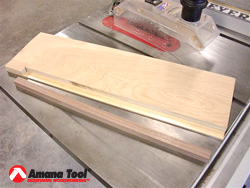How do you rip thin strips on a radial arm saw without the wood splitting and kicking back.?
-Joseph
Lewes2323
How do you rip thin strips on a radial arm saw without the wood splitting and kicking back.?
-Joseph
Lewes2323
Our Expert

Sorry, but I wouldn't rip thin strips on a radial saw. For that matter, I wouldn't rip at all on a radial saw. In my opinion, ripping on a radial-arm saw is just too dangerous. The fence on a radial saw is a crude affair may not be parallel to the saw blade which can cause a kickback. Also, there is too much exposed blade, especially at the trailing end of the cut.
In my opinion, radial saws do a good job of crosscutting (not a great job because the point of contact is just too far from the support, or arm, and even the best radial saws suffer from deflection and wear on the arm. They also need constant tuning to cut precisely.
Instead, I do all ripping on a tablesaw. Today's tablesaw fences are robust and can be finely tuned to ensure that they're parallel to the blade. The blade height can be adjusted to suit the stock thickness and , when adjusted properly, much of the blade is safely below the saw table during ripping. And, as you can see in the attached photo, I always use a guard and splitter or riving knife.
To rip narrow stock on the tablesaw safely, I use a simple "L" shaped jig. The workpiece fits into the "L" and the jig positions my hand a safe distance from the blade. A piece of thin plywood attached to the top of the jig provides downward pressure.
For everyday light ripping I use the Amana Prestige Saw Blade PR1040. When I have a lot of ripping to do I switch to the Amana no.RB1020 European Rip Blade.